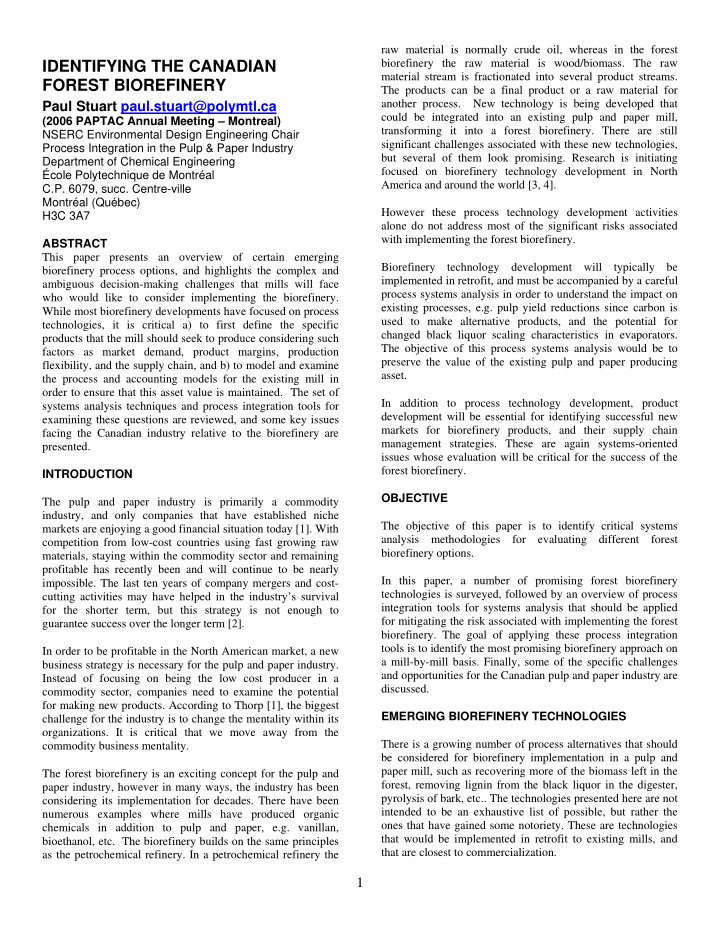



raw material is normally crude oil, whereas in the forest biorefinery the raw material is wood/biomass. The raw IDENTIFYING THE CANADIAN material stream is fractionated into several product streams. FOREST BIOREFINERY The products can be a final product or a raw material for another process. New technology is being developed that Paul Stuart paul.stuart@polymtl.ca could be integrated into an existing pulp and paper mill, (2006 PAPTAC Annual Meeting – Montreal) transforming it into a forest biorefinery. There are still NSERC Environmental Design Engineering Chair significant challenges associated with these new technologies, Process Integration in the Pulp & Paper Industry but several of them look promising. Research is initiating Department of Chemical Engineering focused on biorefinery technology development in North École Polytechnique de Montréal America and around the world [3, 4]. C.P. 6079, succ. Centre-ville Montréal (Québec) However these process technology development activities H3C 3A7 alone do not address most of the significant risks associated with implementing the forest biorefinery. ABSTRACT This paper presents an overview of certain emerging Biorefinery technology development will typically be biorefinery process options, and highlights the complex and implemented in retrofit, and must be accompanied by a careful ambiguous decision-making challenges that mills will face process systems analysis in order to understand the impact on who would like to consider implementing the biorefinery. existing processes, e.g. pulp yield reductions since carbon is While most biorefinery developments have focused on process used to make alternative products, and the potential for technologies, it is critical a) to first define the specific changed black liquor scaling characteristics in evaporators. products that the mill should seek to produce considering such The objective of this process systems analysis would be to factors as market demand, product margins, production preserve the value of the existing pulp and paper producing flexibility, and the supply chain, and b) to model and examine asset. the process and accounting models for the existing mill in order to ensure that this asset value is maintained. The set of In addition to process technology development, product systems analysis techniques and process integration tools for development will be essential for identifying successful new examining these questions are reviewed, and some key issues markets for biorefinery products, and their supply chain facing the Canadian industry relative to the biorefinery are management strategies. These are again systems-oriented presented. issues whose evaluation will be critical for the success of the forest biorefinery. INTRODUCTION OBJECTIVE The pulp and paper industry is primarily a commodity industry, and only companies that have established niche The objective of this paper is to identify critical systems markets are enjoying a good financial situation today [1]. With analysis methodologies for evaluating different forest competition from low-cost countries using fast growing raw biorefinery options. materials, staying within the commodity sector and remaining profitable has recently been and will continue to be nearly In this paper, a number of promising forest biorefinery impossible. The last ten years of company mergers and cost- technologies is surveyed, followed by an overview of process cutting activities may have helped in the industry’s survival integration tools for systems analysis that should be applied for the shorter term, but this strategy is not enough to for mitigating the risk associated with implementing the forest guarantee success over the longer term [2]. biorefinery. The goal of applying these process integration tools is to identify the most promising biorefinery approach on In order to be profitable in the North American market, a new a mill-by-mill basis. Finally, some of the specific challenges business strategy is necessary for the pulp and paper industry. and opportunities for the Canadian pulp and paper industry are Instead of focusing on being the low cost producer in a discussed. commodity sector, companies need to examine the potential for making new products. According to Thorp [1], the biggest EMERGING BIOREFINERY TECHNOLOGIES challenge for the industry is to change the mentality within its organizations. It is critical that we move away from the There is a growing number of process alternatives that should commodity business mentality. be considered for biorefinery implementation in a pulp and paper mill, such as recovering more of the biomass left in the The forest biorefinery is an exciting concept for the pulp and forest, removing lignin from the black liquor in the digester, paper industry, however in many ways, the industry has been pyrolysis of bark, etc.. The technologies presented here are not considering its implementation for decades. There have been intended to be an exhaustive list of possible, but rather the numerous examples where mills have produced organic ones that have gained some notoriety. These are technologies chemicals in addition to pulp and paper, e.g. vanillan, that would be implemented in retrofit to existing mills, and bioethanol, etc. The biorefinery builds on the same principles that are closest to commercialization. as the petrochemical refinery. In a petrochemical refinery the 1
Recommend
More recommend